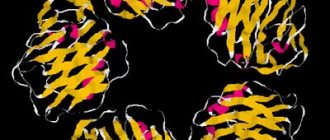Every person should know their blood pH. Acidification of the blood leads to illness and poor health. Severe alkalization - loose skin, dry and brittle hair, nails.
Every liquid has its own level of acid-base balance, including human blood. If there is a disorder in the functioning of the body or a malfunction of a specific system or organ, a PH blood test is done.
- The term blood pH is the level of hydrogen content in the body and general acidity. If the balance of alkalis is maintained, then all systems and organs function normally.
- The acid-base balance is in a normal state if the liver, lungs and kidneys function well and harmoniously. These are real “compensators” that remove harmful substances from the body.
- Therefore, every person should monitor their blood PH level to prevent the development of serious diseases.
Blood PH level of a healthy person: normal
PH level of the blood of a healthy person: normal
The level of alkaline indicator in the blood is the basis for doctors to prescribe treatment if they have large deviations from the norm. Thanks to these indicators, it is possible to monitor the condition of the body, and if malfunctions occur in the functioning of organs or systems, such an analysis should be done.
The normal PH level of the blood of a healthy person is no less than 7.35 and no higher than 7.45. All indicators that differ from the norm to a lesser or greater extent are deviations that are incompatible with life and require urgent medical intervention.
Blood pH level during acidosis
Blood PH level during acidosis
If the acidity in the body is normal, then the PH readings will be at the level of 7.4 units. If this indicator decreases significantly, a diagnosis of “acidosis” is made. The pH level of the blood during acidosis is 7.0 or less.
Mild acidosis does not manifest itself in any way. But, if the indicators decrease to critical limits, which can only be recorded in laboratory conditions, then the person experiences the following symptoms:
- lack of oxygen;
- a feeling of shock at the primary stage of many diseases - diabetes and others;
- nausea;
- vomiting or urge to vomit;
- breathing problems.
Acidification of the body occurs for the following main reasons:
- nervous tension;
- obesity;
- against the background of cardiovascular diseases;
- when eating sweet and meat foods in large quantities.
When a severe form of acidosis is detected, it is necessary to establish the causes of this disease. You should definitely consult a doctor who will correctly prescribe treatment, diet and tell you about all the consequences if you do not control your blood PH level.
Blood acid imbalance
Acid-base balance is an important parameter that is maintained in human blood within certain limits. This is necessary for the normal functioning of various body systems, the occurrence of biochemical reactions, and the optimal functioning of enzymes.
Acids are substances that can give off hydrogen ions, and bases (alkalis) are substances that attach these ions. The acidity and alkalinity of solutions is assessed on a pH scale from 0 (solutions of strong acids) to 14 (solutions of strong alkalis). On the pH scale, neutral acidity is 7.
Normal blood acidity is 7.35 – 7.45 on the pH scale. A shift of this indicator below 7.35 indicates acidosis (a shift in the acid-base balance of the blood towards increasing acidity). When the pH deviates above 7.45, alkalosis occurs (excess of substances with alkali properties in the blood).
During the process of metabolism in the body, products are formed in large quantities that can cause a change in this parameter. The main role in the regulation of acid-base balance belongs to the lungs, kidneys and blood buffer systems.
During breathing, carbon dioxide is released through the lungs, which is formed during the metabolic process in the body. Carbon dioxide, when combined with water, forms carbon dioxide, therefore, if there is an excess of it in the blood, acidosis develops, and if the concentration of carbon dioxide is insufficient, alkalosis occurs.
The kidneys remove excess acids and alkalis from the body with urine. At the same time, these organs, within certain limits, can regulate the amount of acids and bases released and absorbed back, due to which the pH level in the blood is regulated.
Blood buffer systems are solutions of weak acids and alkalis, which combine with excess amounts of acids or bases (depending on the presence of acidosis or alkalosis) to neutralize them, thereby equalizing the pH level.
The cause of acidosis and alkalosis in most cases is the severe course of the underlying disease, in which the resulting changes in blood pH exceed the capabilities of the mechanisms regulating this parameter.
Synonyms Russian
Disorders of the acid-base balance of the blood, disturbances of acid-base homeostasis.
English synonyms
Acid-Base Disorders, Acid-Base Homeostasis.
Symptoms
Manifestations of acidosis and alkalosis are often masked by manifestations of the underlying disease, which caused a change in the acid-base balance of the blood.
Acidosis may have the following symptoms:
- nausea, vomiting
- increased breathing rate
- headache
- disturbance of consciousness (up to coma)
- drop in blood pressure (in severe forms of acidosis)
- heart rhythm disturbances.
Manifestations of alkalosis may include:
- headache
- dizziness
- depression of consciousness (up to coma)
- cramps in various muscle groups
- heart rhythm disturbances
General information about the disease
The acid-base balance in the blood is a vital parameter, the normal values of which are 7.35 - 7.45 on the pH scale.
A pH deviation below 7.35 indicates acidosis. When the pH shifts above 7.45, alkalosis occurs.
Depending on the causes of development, acidosis and alkalosis are divided into metabolic (metabolic) and respiratory (breathing).
Respiratory acidosis develops as a result of the accumulation of large amounts of carbon dioxide in the blood, which combines with water to form carbon dioxide. This causes an increase in blood acidity. This condition can develop with breathing disorders that cause decreased pulmonary ventilation.
This may be the result of lung diseases (for example, bronchial asthma), damage to the nervous system (for example, with brain injuries), diseases, muscles and nerves that lead to loss of the ability to make effective breathing movements (for example, with amyotrophic lateral sclerosis).
The opposite condition is respiratory alkalosis, which occurs when the lungs remove excess carbon dioxide from the body. The mechanism for the development of this type of alkalosis is based on an increase in the rhythm and depth of breathing.
Such breathing disorders can occur in the presence of pathology from various organs and systems (for example, injuries, brain tumors, lung diseases, cardiovascular failure).
Metabolic acidosis can develop for the following reasons:
- increased production of acids in the body. An increase in acid production in the body can be observed in conditions accompanied by metabolic disorders. For example, in diabetes mellitus, the use of glucose by cells is impaired due to a lack of the hormone insulin.
At the same time, the body begins to produce energy not from glucose, but from fats - an alternative way to obtain energy. The breakdown of fats in the liver is accompanied by the formation of large quantities of ketone acids, which leads to acidosis.
- impaired renal function. The kidneys play an important role in regulating the acid-base balance in the blood. In case of kidney diseases that lead to disruption of their functions, the processes of acid secretion and absorption of substances with an alkaline reaction may be disrupted, which can cause acidosis.
- loss of large quantities of alkalis with digestive juices. This condition can be observed with severe diarrhea, surgical interventions on the intestines.
- poisoning with poisons and toxic substances. The breakdown of these substances in the body can occur with the formation of large amounts of acids, which can cause acidosis.
The main causes of metabolic alkalosis are the following:
- loss of large amounts of acidic gastric contents. It can be observed with profuse vomiting, aspiration of stomach contents using a special probe.
- use of diuretics
- increased excretion of hydrogen ions by the kidneys. Such processes can be observed with an excess of the adrenal hormone aldosterone. Aldosterone is involved in the regulation of water and electrolyte balance in the body. An increase in its level can occur both in diseases of the adrenal glands and in pathologies of other organs (for example, heart failure).
Thus, the development of acidosis or alkalosis is often associated with the occurrence of pathological processes in which the resulting changes in acid-base balance exceed the compensatory capabilities of the body. In this case, an important role in treatment is played by the normalization of the patient’s condition for the underlying disease that caused the deviation in blood pH.
Who is at risk?
The risk group for developing acid-base balance disorders in the blood includes:
- persons suffering from lung diseases (for example, bronchial asthma)
- persons with kidney disease with impaired kidney function
- persons suffering from diabetes mellitus
- persons with damage to the nervous system (for example, brain injuries, strokes)
- persons who have suffered large losses of gastrointestinal contents (for example, with excessive vomiting, frequent loose stools)
- persons taking certain medications (eg, diuretics, aspirin)
- persons who abuse alcohol.
Diagnostics
Laboratory research methods play an important role in diagnosis, which allows one to establish the blood pH level, its gas composition, parameters of water-electrolyte metabolism and other vital indicators, monitoring and correction of which are necessary for these conditions.
Laboratory research:
- Determination of blood pH, blood gas composition. Determination of these parameters can be carried out using special devices - gas analyzers. The material for the study is arterial blood.
- General blood analysis. This analysis allows you to evaluate the main characteristics of blood composition: the number of red blood cells, hemoglobin, leukocytes, platelets. This study is not specific for diagnosing acidosis or alkalosis, but is necessary to identify the causes of changes in blood pH.
- General urine analysis with microscopy. This analysis shows the basic physicochemical properties of urine, its pH level, and the presence of pathological and physiological metabolic products.
- Glucose in blood plasma. Glucose is the main source of energy in the human body. An increase in blood glucose levels is observed in diabetes mellitus. Metabolic disorders that occur with this disease can lead to the development of acidosis.
- Potassium, sodium, chlorine in serum. Potassium, sodium, and chlorine are the main electrolytes in the human body that perform many functions. Among them are participation in the transport of substances into the cell and the removal of metabolic products from it, maintaining water and acid-base balance in the body.
- Alanine aminotransferase (ALT). Alanine aminotransferase is an enzyme found in many cells of the body. Most of it is concentrated in the liver. When the liver is damaged, the level of this enzyme in the blood increases. Impaired liver function can lead to changes in the acid-base balance in the blood.
- Creatinine and urea in blood serum. Creatinine and urea are the end products of protein metabolism in the human body. They are excreted from the body by the kidneys. If kidney function is impaired, an increase in these indicators may be observed. Kidney damage can lead to changes in the acid-base balance in the body.
Depending on the specific clinical situation, other laboratory tests may be required to identify the causes of acidosis or alkalosis (for example, determining the level of ketone bodies in the blood and urine, the concentration of lactate in the blood, etc.).
Research:
- Radiography. Chest x-rays can detect pathological changes in the lungs (for example, pneumonia) that result in changes in the rhythm and depth of breathing.
- Ultrasound examination (ultrasound). The method is based on the properties of ultrasound. Using ultrasound, you can visualize internal organs, identify changes in their structure, the presence of space-occupying formations (for example, cysts, tumors), which may be necessary to determine the causes of disturbances in the acid-base balance in the blood.
- Computed tomography (CT). The method allows you to obtain layer-by-layer
highly informative images of internal organs. This is of great importance for identifying the disease that caused acidosis or alkalosis (for example, respiratory failure resulting from cerebral hemorrhage).
Treatment
Treatment of disorders of the acid-base balance in the blood is aimed at treating the underlying disease that led to the development of acidosis or alkalosis. To normalize the pH level, intravenous administration of solutions that neutralize acids (for acidosis) or alkalis (for alkalosis) can be carried out.
Treatment of respiratory acidosis is aimed at restoring the rhythm and depth of breathing with the possible transfer of the patient to artificial ventilation (breathing using a special apparatus in cases of ineffective lung function).
For respiratory alkalosis, inhalation of air mixtures containing carbon dioxide can be used.
Prevention
There is no specific prevention of changes in the acid-base balance in the blood. Patients suffering from diseases that can cause changes in blood pH (for example, diabetes) should strictly follow the recommendations of their doctor and undergo regular examinations and treatment.
Recommended tests
- Blood pH determination
- Determination of blood gas composition
- General blood analysis
- General urine analysis with microscopy
- Blood plasma glucose
- Potassium, sodium, chlorine in serum
- Alanine aminotransferase (ALT)
- Serum creatinine
- Urea in serum
Blood pH level in alkalosis
Blood PH level during alkalosis
Alkalosis, unlike acidosis, appears immediately as soon as the blood PH readings become above 7.45. When the body becomes strongly alkalized, the skin becomes flabby and dry. A person takes on the ugly appearance of a “dried wooden knot.”
The blood pH level during alkalosis is normalized if the causes that caused this deviation are eliminated. The treatment process can begin with breathing exercises. This will help saturate the blood with carbon dioxide and oxygen compounds in the correct proportion. Read more about acidification and alkalization of the body in this article.
Important: Do not self-medicate! It may be dangerous. Never make even rough diagnoses for yourself or your loved ones.
Blood pH level in cancer: comparison
Blood PH level in cancer: comparison
A person's blood PH level fluctuates throughout life. But there are critical indicators when chronic diseases and even cancer can occur. It is bad for the human body when the body is highly acidified, that is, PH values are below 7.45 units, and when a sharp alkalization occurs. If the indicator is below 6.0 units, then the alarm should be sounded.
Blood pH level in cancer is below 6.0. With such indicators, a person has a poor complexion, pale lips, no blush, hair and nails break. We can say that a person has a sick appearance.
Remember: Only a doctor should make a diagnosis! Don't do anything on your own. If you have any doubts about your health, get examined and take the necessary tests. You can only sound the alarm in a timely manner if you feel unwell or other symptoms that interfere with your normal life.
Only a doctor should compare blood pH levels in cancer. He will be able to correctly prescribe treatment and take emergency measures that will be a salvation for your health.
Types of acidosis
There are five main types of what doctors call "metabolic acidosis." This condition means that the body has a poor acid-base pH balance or is working too hard to maintain a healthy pH.
Diabetic ketoacidosis is sometimes mistakenly confused with a state of ketosis. Diabetic ketoacidosis occurs when a person with diabetes's body cannot cope with changes in its condition and the liver produces dangerously high amounts of ketone bodies. This condition is usually diagnosed when blood sugar levels exceed 13 mmol/L.
Hyperchloremic acidosis condition with excessive vomiting or diarrhea. With this form of acidosis, there is a decrease in the level of sodium bicarbonate and an increase in the concentration of chloride in the blood plasma.
Lactic acidosis – Too much lactic acid can lead to acidosis. According to scientific journals, “causes of this condition may include chronic alcohol use (alcoholism), cardiac arrest, cancer, liver failure, decreased oxygen levels in the air, and low blood sugar.” Additionally, prolonged exercise can lead to a buildup of lactic acid in the blood.
Renal tubular acidosis - If your kidneys cannot produce enough acid in your urine, your blood may become acidic.
Dietary acidosis is a recently recognized form of acidosis. Dietary acidosis (or “diet-induced acidosis”) is the consequence of eating highly acidic (not lemon) foods, which places a very high burden on the body, increasing the risk of various diseases and deteriorating overall functioning. body. []
How to measure blood PH at home with a device, test strips?
How to measure blood PH at home with a device, test strips?
Of course, if you have any health problems, you should go to the clinic to see a doctor. But it often happens that we don’t have time to go to the hospital - don’t be upset. You can measure blood PH at home with a device or test strips.
A special device is sold at a pharmacy or any medical equipment store. It is inexpensive, but very useful for measuring blood PH at home. If you can’t find such a device, use test strips. They are sold in every pharmacy and cost pennies. If you don’t find any strips or a tester at the pharmacy, you can order everything you need online.
How to measure blood PH at home with test strips - tips:
- Prick the finger of your right hand with a scarifier, which is also sold in pharmacies.
- Squeeze some blood into a small container. It's good if you have a laboratory test tube.
- Dip the test strip into this blood, hold it for a few seconds, remove it from the tube, and evaluate the result.
- The scale for determining the alkaline reaction in the body is on the package with strips. Compare the color and find out the result.
When measuring PH values using the device, it is faster, easier and more convenient. You do not need to pierce your finger, the device will do everything on its own: puncture, sampling and give the result.
Testing the pH level of acid-base balance
This is how you can check your own pH level
- You can test your pH by purchasing pH test strips from your local health food store or pharmacy.
- pH measurements can be made using saliva or urine. The second morning urination gives the best pH results in terms of accuracy.
- You compare the colors on the test strip to the pH scale chart that comes with this test strip kit.
- During the day, the best time to check your pH is one hour before meals and two hours after meals.
- If you are testing your saliva, the ideal pH range for health is between 6.8 and 7.3 (remember, optimal pH is around 7.365).
Source:
Code of Life
We recommend:
An integrated approach to cancer treatment
Where can I get a blood PH test?
Where can I get a blood PH test?
Laboratory tests are much more accurate than those obtained at home. If you decide to take a blood PH test in a special laboratory, you can go to the clinic at your place of registration or to any private clinic. The analysis will be ready on the day of blood sampling. The doctor himself may suggest that you take a test during a routine examination or preventive procedures if there are deviations in your health.
What does blood PH depend on?
What does blood PH depend on?
If the pH level becomes too low - less than 7.35 (acidic) or too high - more than 7.45-8 (alkaline), then the cells of our body begin to poison themselves with toxic emissions and die. Slags and toxins appear in large quantities. In this case, many people begin to remove these harmful substances from the body. But you just need to bring the PH levels of blood, urine and saliva back to normal. What does blood PH depend on?
This indicator depends on the following factors:
- Nutrition - you need to learn the basics of proper nutrition. Our body must maintain a balance of proteins, fats and carbohydrates.
- Stress resistance - constant nervous tension leads to acidification of the body. Learn to be calm and not get nervous over trifles.
- Obesity - When the body is acidic, it begins to accumulate fat. If you alkalize, you will immediately begin to lose weight, which means your well-being, skin and hair condition will improve.
The acid-base balance in the body depends on maintaining the correct proportions between intercellular and intracellular waters in the tissues. If the acid-base balance of liquids is not maintained constantly, it will be impossible to preserve life and the normal functioning of all organs and systems.
What does PH depend on?
Symptoms of changes in blood pH
If the blood pH is outside the healthy range, he may begin to experience certain symptoms.
The symptoms people experience will depend on whether their blood becomes more acidic or less acidic.
Some symptoms of acidosis include:
- headache
- confusion
- fatigue
- lethargy and drowsiness
- cough and shortness of breath
- uneven or rapid heartbeat
- upset stomach or nausea
- muscle cramps or weakness
- loss of consciousness and coma
Symptoms of alkalosis include:
- confusion and confusion
- trembling hands
- numbness or tingling in the legs, arms, or face
- muscle cramps
- vomiting or nausea
- coma
How to reduce acidity and raise blood pH?
How to reduce acidity and raise blood pH?
Acid-base balance is our indicator of health. The more “sour” a person is, the faster he begins to age and get sick more. For the normal functioning of all organs and systems, the PH level in the body must be alkaline at least 7.35 units. How to reduce acidity and raise blood pH? Some tips:
- Eliminate meat products from your diet. You can fish, but in small quantities.
- It is important to make your nutrition correct. Get the right ratio of proteins, fats and carbohydrates. Use boiled and steamed dishes, exclude everything fried. Eat more fresh fruits and vegetables.
- Stop being nervous. Reconsider your attitude towards life - eliminate stressful situations.
- Practice separate meals. This will help the body quickly reduce acidity and normalize digestion. Products consumed separately will be better digested.
You can use special drops that are sold in pharmacies to alkalize the water. Alkaline water will help reduce acidity levels, and the kidneys, stomach and intestines will begin to work well. If your body is highly acidic, switch to a raw food diet.
But remember! Conducting experiments on your own is dangerous! Consult your doctor before following an alkaline diet or drinking alkaline water.
What is acid-base pH balance? And why is this the key to good health?
What we call “ pH balance ” is a measure of the activity of hydrogen ions in solutions. [I] pH values are a measure of the acidity or alkalinity of fluids in body tissues. pH values range from 0 to 14. The more acidic the solution, the lower the pH values. More alkaline liquids show higher pH values. The pH scale measures the acidity or alkalinity of many liquids, such as the water in the oceans and seas, not just our blood.
What should the ideal acid-base pH balance be? PH=7 is considered neutral, which means the liquid is equally acidic and alkaline. The pH of the blood serum, as well as the pH of most tissues of our body, should remain around 7.365 , while in the stomach the pH balance is determined to be about 2 units. This strong acidity in the stomach is necessary to process food. Our saliva or urine is also slightly acidic and is in the pH range of 6.4-6.8 in healthy people.
If a person practices an alkaline diet, then it helps him restore the correct level of acid-base balance and helps improve health.
An alkaline diet has been shown to help:
[, , , , ]
- Protection against cardiovascular diseases
- Prevention of calcium accumulation in urine
- Prevention of urolithiasis , kidney disease or damage
- Reduce general inflammation
- Reducing the risk of developing diabetes
- Maintain good bone density
- Reducing the likelihood of muscle cramps
- Protection against vitamin D and related consequences
- Reducing lower back pain
How to increase acidity and reduce blood pH?
How to increase acidity and reduce blood pH?
It is bad for the body when the alkaline balance of the blood is greatly increased and has high levels. How to increase acidity and reduce blood pH? Adviсe:
- Eat acid-containing foods - grains, legumes, protein foods (meat, eggs).
- Eat foods rich in dietary fiber.
- Three times a day you can take 1 tablespoon of apple cider vinegar with honey.
- Vitamin C lowers pH levels.
- Do breathing exercises with deep breaths.
- If there are no medical contraindications, you can use dietary supplements - food enzymes and others.
- Correct the vitamin status in the body by taking multivitamin complexes.
Also, to increase acidity, it is necessary to carry out prevention and adequate treatment of the genitourinary system.
The best ways to maintain the correct acid-base pH balance
First, you can reduce your risk of falling out of healthy pH by looking at how your lifestyle and habits may be affecting your nutrient levels, gut function, and immune system.
Below are the main factors that contribute to the growth of acidity (acidosis) in your body
- Alcohol and drug use (including acetazolamide, opioids, tranquilizers, and aspirin)
- Excessive use of antibiotics
- Kidney disease or kidney dysfunction
- Poor digestion and poor gut health
- Eating a lot of processed and refined foods containing salt, preservatives, etc. []
- Low dietary intake of potassium, calcium and other beneficial minerals []
- High consumption of artificial sweeteners, food colors and preservatives
- Pesticides and herbicides that may remain in plant products
- Chronic psychological stress
- Sleep disorders, such as apnea
- Decreased nutritional levels in food due to industrial agriculture and poor topsoil quality
- Low levels of fiber in the diet
- Lack of exercise (sedentary lifestyle)
- Excess animal meat in the diet
- Excessive ingestion of cosmetics and plastic residues into the body
- Exposure to chemicals from household cleaning products, building materials, radiation from computers, cell phones and microwave ovens
- Environmental pollution
- Poor chewing and eating habits (eating quickly without chewing thoroughly)
- Lung disease or damage, including emphysema, chronic bronchitis, severe pneumonia, pulmonary edema, and asthma
How does calcium affect blood pH?
How does calcium affect blood pH?
Calcium is an alkaline substance. How does calcium affect blood pH? Our body is a smart “system”. In order to prevent critical indicators of the acid-base balance, with strong acidification, it begins to extract calcium and magnesium from our bones and teeth.
When the body is acidified, it will be useful to take a course of calcium. But this substance is well absorbed if taken along with magnesium and vitamin D3. The pharmacy sells special vitamin complexes with calcium. There is a lot of magnesium in fresh herbs and green vegetables.
How to maintain a constantly normal blood pH level?
How to maintain a constantly normal blood pH level?
If acidity levels are normal, it is recommended to regularly take tests and check the PH level. How to maintain a constantly normal blood pH level? Adviсe:
- Make it a habit to eat right. Eat at least 5 servings (1 serving - 100 grams) of fresh vegetables and fruits. There are food products that are especially enriched with vitamins, minerals and contribute to the balance of nutrients.
- Lead a healthy lifestyle and exercise. Quit smoking and drinking alcohol - all this strongly and quickly acidifies the body.
- Drink mineral water without gases, freshly squeezed juices, herbal teas.
- Eliminate fatty, high-calorie, smoked foods, coffee, tea from your diet.
Harmful compounds that accumulate during acidification of the body do not leave the body, but are deposited on the walls of blood vessels. To get rid of the effects of acidification, it is necessary to carry out long-term cleaning measures. Therefore, it is better to always keep your blood pH, as well as urine and saliva, normal.
How can you help your body achieve a neutral pH level?
Below are steps to help you maintain a better acid-base pH balance.
Reduce intake of acidic foods
If you currently eat a " standard Western diet " then you may need to change your diet to be more alkaline. Here is a list of acidic foods that should be limited in your diet or completely excluded from your diet:
- Store-bought processed meats, cold cuts, hot dogs, sausages, salami.
- Foods High in Salt
- Sugar and sugar products
- Processed cereal grains such as corn, wheat, barley, sorghum, millet and rye (including flour from these cereals)
- Regular meat (beef, chicken and pork)
- Fried foods
- Milk and dairy products
- High glycemic index foods including white rice, white bread, pasta, breakfast cereals, etc.
- Caffeine
- Alcohol
There are some "sour" foods that contain many essential nutrients, so rather than being completely eliminated from your diet, they can be consumed in moderation as part of a healthy diet.
- Most high protein foods such as meat and eggs
- Lentils and other legumes
- Oats
- Brown rice
- Whole wheat bread
- Walnut
Go on an alkaline diet
If you plan to follow an alkaline diet to balance your pH, then your diet should be rich in green plants and other alkaline foods. It is also wise to buy more organically grown food (not from standard farming methods, but from farms or private gardens). These foods are grown in a more organic environment, in soil that is high in minerals, which tend to be more alkalizing and contain more vitamins.
HERE IS A LIST OF FOODS THAT WILL CONTRIBUTE TO AN ALKALINE DIET
- Leafy green vegetables - kale, chard, beet greens, dandelion greens, spinach, wheatgrass, alfalfa, etc.
- Other non-starchy vegetables - mushrooms, tomatoes, avocados, radishes, cucumber, broccoli, oregano, garlic, ginger, green beans, endive, cabbage, celery, zucchini and asparagus
- Raw Foods – Raw fruits and vegetables are biogenic or “life-giving” foods for our body. Cooking, especially cooking, can reduce the content of alkali minerals. Increase the amount of raw food in your diet and try lightly steamed vegetables. Ideally, try to consume most of your foods raw, or only lightly cooked (such as steamed).
- Superfoods (healthy foods) - maca root, spirulina, sea vegetables, bone broth and dried greens powder containing chlorophyll
- Healthy fats: Coconut oil, olive oil, fish oil, fat from farmed or home-raised animals (these foods can be good additions to your diet, even if they are not necessarily alkalizing).
- Starchy plants include sweet potatoes, turnips and beets.
- Plant proteins - almonds, beans, kidney beans and most other legumes
- Most fruits - Surprisingly, sour-tasting fruits such as lemon or grapefruit do not create acidity in the body. They do just the opposite and contribute to alkalization of the body. Citrus fruits, dates and raisins are highly alkalizing and can help prevent acidosis. []
- Vegetable juices (green drinks) are drinks made from green vegetables and herbs in powder form. Such foods are very rich in chlorophyll . Chlorophyll is structurally similar to our own blood and alkalinizes the blood. []
- Apple cider vinegar has a sour taste, but is able to restore the acid-base pH balance well.
Depending on your current health status and your health goals, you could achieve better acidity status by following an alkaline, very low-carb, ketogenic diet. The keto diet (ketogenic) also maintains pH balance in the body by eating healthy fats, green leafy vegetables, vegetable juices and superfoods (healthy foods). But it’s worth knowing all the pros and cons of the ketogenic diet before you start practicing it.
Most high-protein foods are acid-forming, so if you eat a lot of meat and animal products, it's important to balance out their acidic influences with alkalizing plant-based foods. [] If you are following a low-carb diet to reduce acidity, then in addition to the foods mentioned above, you can add beans, nuts and some small amounts of starchy foods (they contain a lot of carbohydrates and sugar).
Drink alkaline water
According to the US Water Research Center, “...the normal pH range for surface water systems is 6.5 to 8.5 and for groundwater systems is 6 to 8.5...” [] This means that there are many varieties of water with different pH.
When water has a pH level of less than or around 6.5, it can be characterized as “acidic and corrosive.” Such water can leach metal ions such as iron, manganese, copper, lead and zinc from aquifers, faucets and pipes, and may also contain toxic metals and have a sour taste. The best way to change the problem of acidic water (low pH) is to use a special neutralizer that can increase the pH .
Water that shows a pH between 9 and 11 can be considered alkaline. Distilled water has a neutral pH of about 7. [] Adding baking soda to acidic water can also increase the alkalinity of the water.
Water filtered with a reverse osmosis filter is slightly acidic, with a pH of just under 7. Distilled water and filtered water may not become too alkaline, but if you are not too concerned about the acidity of such water, then such waters can be considered a better option in comparison. with tap water or plastic bottled water, which is more acidic.
Reduce the entry of drugs, toxins and chemicals into your body
Many different medications, chemicals and toxins can disrupt the acid-base pH balance and contribute to increased acidity in the body. Such products include: alcohol, caffeine, acetazolamide, opioids, sedatives, carbonic anhydrase inhibitors, nonsteroidal anti-inflammatory drugs (NSAIDs), and aspirin . []
It is important to exclude as much as possible from your life all influences that can lead to the constant use of various medications . For example, lack of sleep, psychological stress, sedentary lifestyle and even allergies can cause problems with your health, which will push you to take various medications.
Try to determine what steps you can take to naturally reduce your need for medications. If you live or work in an environment with a lot of air pollution , then it is worth taking steps to protect yourself as much as possible from such pollution.
What foods acidify the blood: table
Plan your diet and lifestyle in such a way that you do not have problems with blood alkaline levels. A healthy diet will help you maintain health and youth throughout your life. So, what foods acidify the blood? Table:
What foods acidify the blood: table
If your blood is highly acidified, change your eating habits. Proper nutrition has been in fashion for several years now, but there are still many people in the world who do not know what this term means.
What foods alkalinize the blood: table
If you have health problems, take a blood test to check your PH level. Acidified blood must be alkalized, otherwise failures in the functioning of organs and systems will lead to the most unpleasant consequences. What foods alkalinize the blood? Table:
What foods alkalinize the blood: table
You will see more detailed information about foods that alkalize and acidify the blood in this article on our website. It is important to remember that in a neutral biological environment our body has an amazing ability to heal itself. Therefore, strive to maintain your acid-base balance normal so as not to get sick and stay young for a long time.
What causes acid-base imbalance?
Here's the definition of acidosis, a condition where your pH level shifts toward a more acidic state: "...is the overproduction of acid in the blood or excessive loss of bicarbonate from the blood (metabolic acidosis), or the accumulation of carbon dioxide in the blood, which results from poor lung function and depressed breathing (respiratory acidosis).” []
Your body almost always does an excellent job of maintaining your acid-base balance at an optimal level. Unfortunately, you are given the “key” from birth on how hard your body will work to achieve optimal pH values.
Normally, our kidneys maintain proper pH balance and electrolyte levels, including calcium, magnesium, potassium and sodium. But when we are exposed to acidic substances, these electrolytes are used (used up) to combat acidity .
The kidneys begin to excrete more minerals from the body through urine. A highly acidic diet or body health condition causes our body to draw minerals (electrolytes) from our bones, cells, organs and tissues. Our cells have a serious need for sufficient minerals to produce their waste products. Therefore, first of all, with an increase in acidity, a loss of minerals occurs in the bone tissue (bones), which contributes to the development of osteoporosis. When cells work hard in an oxidized environment, the process of accumulation of toxins and pathogens can begin that the cells do not have time to eliminate, and this, in turn, can suppress the immune system.
Once you switch your body to an altered acid-base balance with a predominance of acidity, you force your body to work overtime to keep your blood in the neutral pH zone. This type of strenuous work by the body disrupts the levels of various substances that the body uses to perform its task of maintaining pH. These disorders include decreased potassium levels, imbalanced sodium ratios (our ancestors had a 10:1 potassium to sodium ratio, while modern humans exhibit a 1:3 ratio), decreased magnesium levels , very low fiber intake values, and earlier loss of function. kidney function, especially during aging. [AND]
You cannot cause your blood pH imbalance on your own (which can lead to death), but you can, through your actions, reduce your body's endurance, which will prevent you from experiencing healthy aging . Only helping your body maintain a normal acid-base balance can provide you with healthy years of life.










